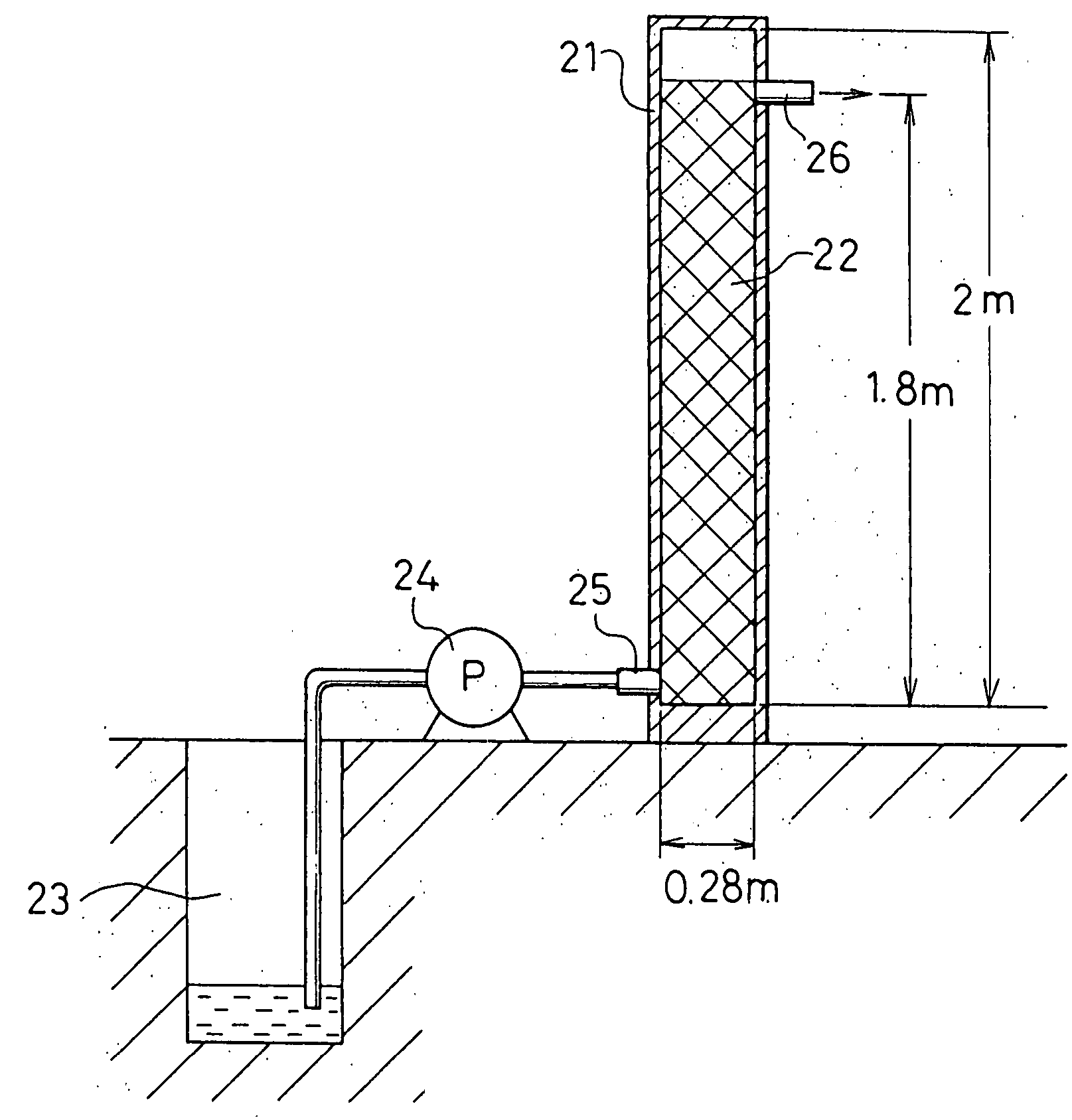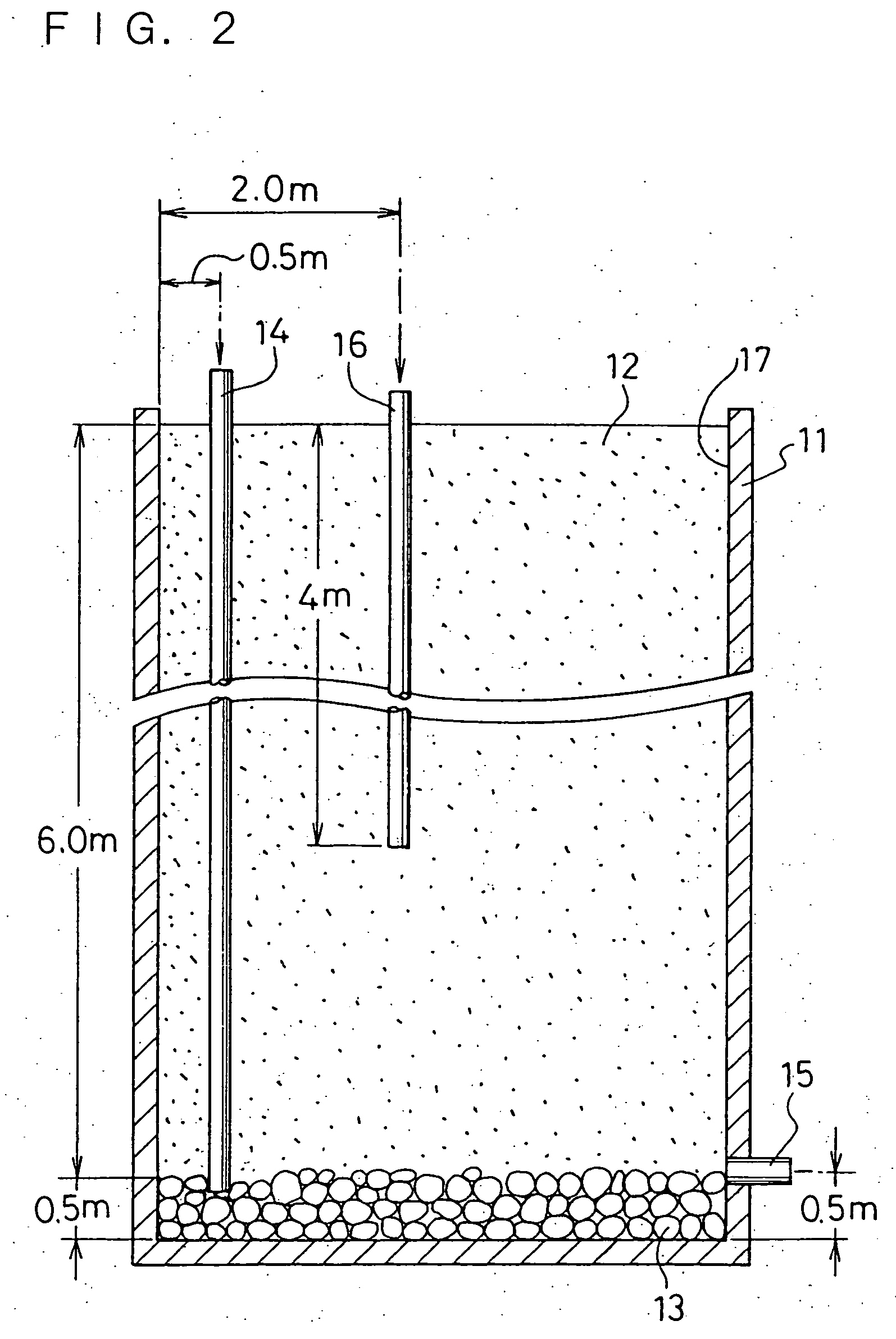Method of decreasing nitrate nitrogen and volatile organic compound in soil and groundwater
a technology of volatile organic compounds and nitrate nitrogen, which is applied in the direction of cleaning apparatus for vehicle exteriors, contaminated groundwater/leachate treatment, biological water/sewage treatment, etc., can solve the problems of secondary pollution, large structure and complex structure, and achieve high biological denitrification ability, the effect of decreasing nitrate nitrogen
- Summary
- Abstract
- Description
- Claims
- Application Information
AI Technical Summary
Benefits of technology
Problems solved by technology
Method used
Image
Examples
example 1
[0078]FIG. 1 is a sectional view showing an artificial soil experiment facility used for effecting a soil experiment in a method of decreasing nitrate nitrogen and volatile organic compounds in Example 1.
[0079] As shown in FIG. 1, the artificial soil experiment facility used in Example 1 has 14 compartments of experiment baths 7 separated mutually by a concrete frame 1, and a measurement water incorporating port 4 is formed at the bottom of these experiment baths 7. On each experiment bath 7, nozzles are placed for adding a nitrate nitrogen solution, and these nozzles are communicated with a pipe 6 in which the nitrate nitrogen solution flows.
[0080] The following experiments were conducted using the artificial soil experiment facility constituted as described above.
[0081] In the experiment bath 7, a gravel layer 3 and experiment soil 2 are placed. In each experiment soil 2, a carrot seedling 5 is planted.
[0082] The ground surface area of the experimental bath 7 was 11 m2, and th...
example 2
[0096]FIG. 2 is a sectional view showing an artificial groundwater experiment facility used for effecting a groundwater experiment in the method of decreasing nitrate nitrogen and volatile organic compounds in Example 2.
[0097] As shown in FIG. 2, in the artificial groundwater experiment facility used in Example 2, experiment soil 12 mixed with an experiment material and a gravel layer 13 were placed in an experiment bath 17 formed with a concrete block frame 11, before experiment. In the experiment bath 17 surrounded by the concrete block frame 11 in the artificial groundwater experiment facility, the ground surface area of the experiment soil 12 was 18 m2, and the soil depth was 6.0 m. Under this experiment soil 12, a gravel layer 13 is formed at a thickness of 50 cm. A mixture of kuroboku soil and loam at a ratio of about 6:4 was used as the experiment soil 12.
[0098] In the experiment bath 17, an artificial well 14 constituted of a vinyl chloride tube having a diameter of 20 cm ...
example 3
[0109]FIG. 3 is a view showing the structure of a column experiment apparatus used for effecting the method of decreasing nitrate nitrogen and volatile organic compounds in Example 3. Here, the column is a vessel having a function of decreasing nitrate nitrogen and volatile organic compounds, and decreases nitrate nitrogen and volatile organic compounds by allowing groundwater such as well water and the like to pass. In Example 3, a resin column having a diameter of 28 cm and a height of 2 m was used.
[0110] As shown in FIG. 3, an experiment material 22 is filled in the column 21. Well water evacuated from a well 23 by a pump 24 flow into this column 21 through an introduction port 25 of the column 21. It is so constituted that well water which comes into with the experiment material 22 while rising in the column 21, is discharged from an outflow port 26 formed at the upper part of the column 21.
[0111] Column experiments were conducted as described below using the column experiment...
PUM
 Login to View More
Login to View More Abstract
Description
Claims
Application Information
 Login to View More
Login to View More - R&D
- Intellectual Property
- Life Sciences
- Materials
- Tech Scout
- Unparalleled Data Quality
- Higher Quality Content
- 60% Fewer Hallucinations
Browse by: Latest US Patents, China's latest patents, Technical Efficacy Thesaurus, Application Domain, Technology Topic, Popular Technical Reports.
© 2025 PatSnap. All rights reserved.Legal|Privacy policy|Modern Slavery Act Transparency Statement|Sitemap|About US| Contact US: help@patsnap.com



